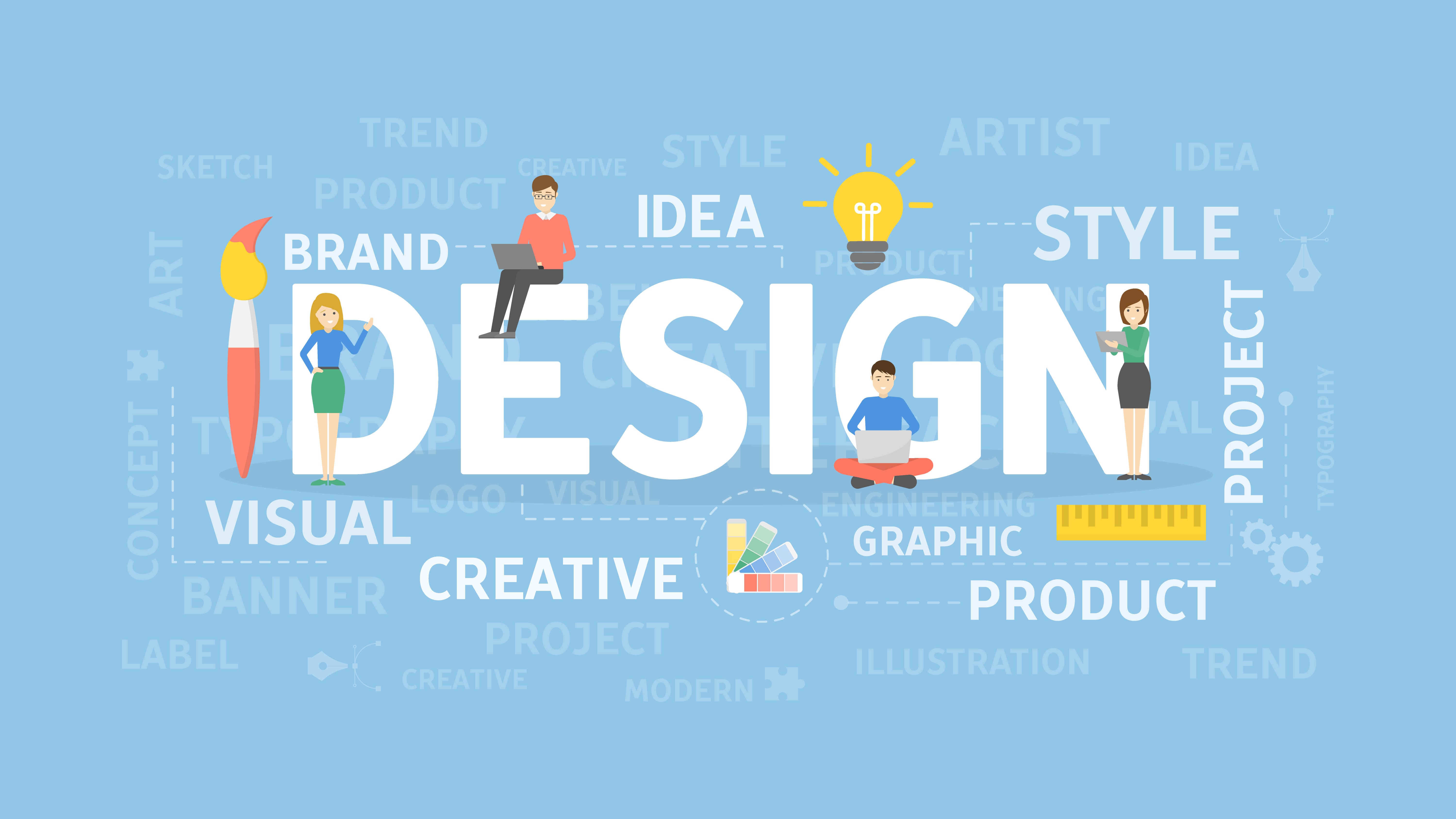What is Graphic Design: Principles and Elements

Graphic design has a significant influence on contemporary organizations since it is essential for drawing customers in, delivering messages, and creating powerful brands. If you are a small-to-midsize business owner and you realize the value of graphic design, you may find it difficult to outsource design services since you do not have a fundamental grasp of aspects and concepts like balance, space, hierarchy, typography, and color. An in-depth discussion of these fundamental ideas will be provided in this article, enabling you to assess agencies, interact with designers, and anticipate what the design process entails.
What is Graphic Design?
Graphic design is “the art and practice of planning and projecting ideas and experiences with visual and textual content,” according to the American Institute of Graphic Arts (AIGA). In simple terms, graphic designers create visuals to communicate specific messages, ranging from simple business logos to complex web page layouts. As graphic designer Alexandros Clufetos puts it, “Graphic design helps the producer connect with the consumer,” effectively conveying the message of a project, event, campaign, or product. Companies use graphic design to promote and sell products through advertising, convey complex information in an easy-to-understand format like infographics, develop a brand identity, and much more. While most graphic design work serves commercial purposes, many designers also use it for artistic expression.
This broad and ever-evolving subject has a big impact on how we view and engage with companies and information. Beyond aesthetics, graphic design is important because it helps you successfully communicate your message and leave a lasting impact. Every aspect of your business's visual presence—logos, websites, marketing materials, product labels, and social media graphics—contributes to how the world perceives your brand. As we explore the principles and elements of graphic design in the following sections, the methods and strategies behind this impactful form of communication will become clearer.
1. Eight Graphic Design Principles
Comprehending fundamental design concepts is crucial for graphic designers to produce designs that are both harmonious and impactful. These principles ensure that your designs clearly communicate your ideas and demonstrate how the various graphic elements interact cohesively. While the terms "principle" and "element" are often used interchangeably in graphic design, they have distinct meanings. Let's explore these principles further to understand their importance in creating successful designs.
2. Contrast
A key concept in graphic design that all designers need to understand is contrast. It describes how different design elements—like color, size, form, or typography—are used to emphasize and create differentiation. For example, if your design features dark background elements, using light-colored text will enhance readability and ensure clear differentiation between components. By juxtaposing elements with contrasting qualities, designers can draw attention to specific focal points, convey hierarchy, and add visual impact. Effective use of contrast makes key information stand out, improves readability, and contributes to dynamic and memorable compositions.
3. Balance
As a graphic designer, it's crucial to understand that every element in your design carries weight, influenced by factors such as color, size, or texture. Balance refers to the strategic placement of these elements to achieve visual stability and harmony. Balance comes in two types: symmetrical and asymmetrical. Symmetrical balance involves aligning equally weighted elements to create a sense of order, while asymmetrical balance uses a combination of heavier and lighter elements to achieve contrast and visual interest. Proper balance ensures that no single element overwhelms the composition, resulting in a harmonious and visually pleasing design that puts the viewer at ease.
4. Repetition
Repetition is a powerful tool in graphic design that reinforces ideas and unifies a project. It involves the deliberate and consistent reuse of specific design elements, such as colors, shapes, fonts, or visual patterns. Designers establish a feeling of uniformity, consistency, and visual rhythm by repeating these components; this aids in reinforcing important messages and directing the viewer's attention. For instance, limiting your design to two typefaces and consistently using them throughout the project can prevent visual chaos and create a cohesive and professional look. Repetition not only enhances the overall design concept but also ensures that the composition appears organized and harmonious.
5. Hierarchy
The hierarchy concept in graphic design highlights the need for the most significant components of your design to stand out visually. This ensures that viewers can easily identify and understand the key components. Hierarchy involves arranging design elements to indicate their relative importance. By manipulating factors such as size, color, contrast, alignment, repetition, and brightness, designers can draw attention to the most critical elements and minimize the focus on less important ones. Using hierarchy well aids in clearly conveying the design's message and directs the viewer's attention through the composition.
One can establish a hierarchy by:
* use strong or huge fonts to draw attention to the title;
* putting the important message above other components;
* Adding shapes to frame the focal view;
* Implementing detailed and colorful visuals.
6. Alignment
An essential component of design, alignment establishes a visual relationship between forms, text blocks, and pictures. It ensures a sharp and orderly appearance by eliminating distortion within the layout. Proper alignment involves the precise positioning of elements in relation to one another or to a defined grid layout, which helps develop a clean and organized design structure. By comparing the proportions of each element and focusing on those with a strong impact, alignment enhances readability, clarity, and the overall visual appeal of the design.
7. Rhythm
In graphic design, rhythm unites disparate components to provide a more coherent and unified appearance. By repeating elements such as logos or colors, rhythm helps make a brand easily recognizable and strengthens the overall design. This principle can be understood by comparing it to music, where repeating elements create spaces that establish a visual rhythm, similar to musical compositions. Rhythm is classified into two types:
* Fluid Rhythm: Introduces significant variation while maintaining a consistent flow in a single direction.
* Progressive Rhythm: Follows a clear sequence, guiding the viewer's visual movement between different elements.
8. Proximity
Proximity aids in decluttering a design by establishing relationships between related elements. It creates a visual connection among crucial design factors such as color, font, type, and size, ensuring a balanced and cohesive layout. Proximity allows the audience to easily understand the visual hierarchy, providing a pleasant and intuitive user experience.
9. Color and space
Selecting appropriate colors is essential for establishing the tone of a design. Designers have a multitude of color combinations to choose from for both background and text elements. Space, on the other hand, encompasses the area surrounding or between different design elements and can be utilized to form shapes or emphasize key aspects of the design. Graphic designers utilize color palettes to select colors that either create contrast or harmonize with other elements within the composition.
Elements of Graphic Design
To construct their designs, graphic designers use basic components referred to as design elements. These elements, combined with the principles of graphic design, serve as the guidelines and techniques to guide designers in their work. Graphic design also includes features such as lines, forms, texture, value, scale, and color, in addition to the standard components of pictures and typography. Designers working in both print and web media leverage these elements to craft effective designs with the aim of capturing viewers' attention and, at times, prompting specific actions.
Lines
Lines serve as foundational elements in graphic design, offering versatility in their characteristics. They can be straight, curved, thick, thin, solid, or dashed, serving various purposes such as connecting points, delineating sections, and directing the viewer's gaze. Their attributes evoke emotions, suggest movement, organize content, and more. For instance, jagged lines can convey the intensity of emotion, while arrow-ended lines compel the viewer's attention toward a specific direction. Meandering lines guide the viewer fluidly through different elements on the page. As a fundamental element, lines play a crucial role in establishing structure, defining boundaries, and orchestrating visual flow. They are strokes extending between two points, capable of expressing a wide range of characteristics, including thickness, length, style, and curvature.
Shape
Shape in graphic design refers to the two-dimensional area defined by lines or curves, offering visual form and structure to designs. It can be composed by arranging other design elements like lines, color, and texture. Shapes are important for depicting objects, eliciting feelings, and conveying ideas. They can be categorized as geometric, such as squares, circles, and triangles, or organic, resembling natural forms. Shapes are integral to visual communication as they provide substance to images and aid in recognition. Whether in the form of basic geometric shapes like squares and circles, or more complex symbols and icons, they contribute to the clarity and visual interest of a design.
Texture
Texture is a sensory quality that contributes depth, dimension, and tactile appeal to graphic designs. It encompasses the visual and sometimes physical surface quality of an object, enhancing engagement and immersion by evoking a sense of touch. Graphic designers leverage texture to enrich designs, layering graphics to simulate real-life textures and create a sense of realism or abstract artistic expression. Techniques like rhythm and shadow contribute to the visual "feel" of elements, serving as backgrounds, enhancing overall appearance, and adding character to other design components such as type and images.
Color
In graphic design, color is a potent tool that may elicit strong feelings, convey ideas, and provide visual appeal. It plays a crucial role in creating contrast, establishing hierarchy, and evoking specific emotions or associations within a design. The color wheel is an invaluable resource for comprehending color connections and how they affect successful design. On the color wheel, complementary colors are opposite one another and produce contrast and visual interest, whereas analogous colors are next to one another and promote harmony and unity. Color attracts attention and communicates mood and emotion, with each color carrying its own symbolic associations. For instance, red symbolizes strength, anger, or passion, while blue evokes feelings of peace, professionalism, or security.
Typography
Typography is the skillful arrangement of letters and text to ensure that written language is both legible and visually appealing when presented. It encompasses the selection and arrangement of fonts, sizes, spacing, and other typographic elements to effectively convey meaning and emotion. In order to organize information inside a design, focus the viewer's attention, and navigate them through the material, typography is essential. Different typographic elements, such as headings, subheadings, and body text, are utilized to convey varying levels of importance within the composition.
Image
In the realm of graphic design, an image serves as a visual depiction, typically comprising a photograph, illustration, or artwork, employed to convey a distinct message or enhance aesthetic appeal. Images hold significance in visual communication and narrative-building, enabling designers to elicit emotions, elucidate concepts, and establish a rapport with the audience.
Space
Space, often referred to as negative space, involves purposefully incorporating empty areas within a design. These voids devoid of visual elements enable the design to have room to breathe, fostering a sense of openness and clarity. Effective utilization of negative space has the potential to convert a cluttered and chaotic design into one that exudes openness, cleanliness, and a welcoming ambiance.
Conclusion:
In all, understanding the principles and elements of graphic design is paramount for small-to-midsize business owners seeking to leverage visual communication effectively. By grasping concepts such as balance, contrast, hierarchy, and typography, individuals can better assess design agencies, collaborate with designers, and anticipate the creative process involved. Graphic design serves as a powerful tool for conveying messages, establishing brand identities, and engaging audiences across various platforms. With a foundational understanding of these principles and elements, businesses can enhance their visual presence, create compelling brand experiences, and ultimately drive success in today's competitive landscape.
Hire Python Developers
Hire Python developers who can turn your vision into reality. Hire the most skillfull python developers from Fulllancers.



